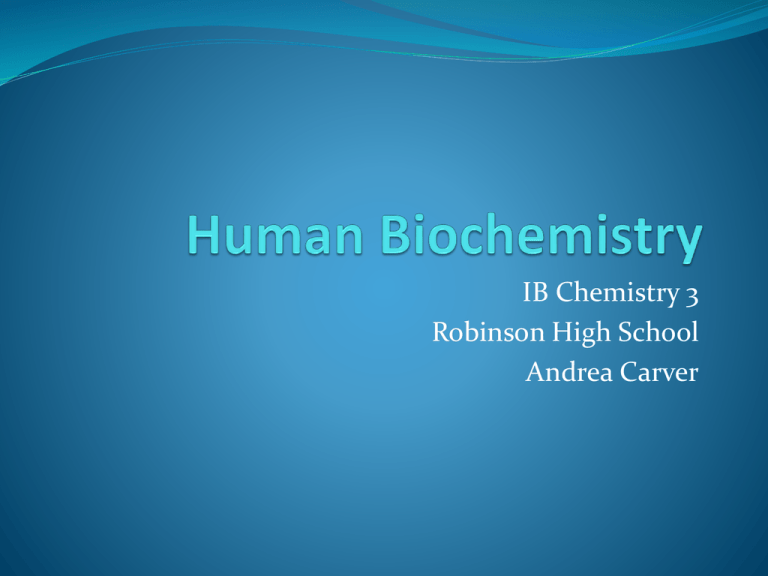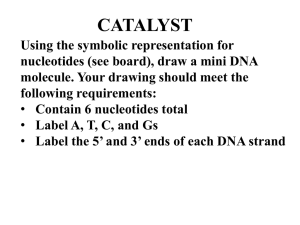
IB Chemistry 3
Robinson High School
Andrea Carver
Biochemistry is…
The study of the chemical processes occurring in living
organisms.
Includes processes involving the flow of both energy
and information.
Deals with biomolecules such as proteins,
carbohydrates, lipids, and nucleic acids.
Energy: IB Objectives
B.1.1 Calculate the energy value of a food from enthalpy
of combustion data.
Energy
Every living cell contains thousands of biological
molecules each of which is involved in the interlinked
processes of metabolism.
Cellular respiration is the oxidative process by which
energy stored in food is made available for use by the
cell.
O2
Starch
Protein
Rxns of Respiration
Glucose
Glycogen
Fats
Energy
CO2 + H2O
Measuring Energy Production
Combustion analysis is used to determine the amount
of energy produced from a unit of a particular food.
A bomb calorimeter measures the heat of
combustion of a reaction.
Food is burned within the calorimeter, and heat
released raises the temperature of a known quantity of
water.
Calculation of Energy Release
Formula: q=mc∆T
q= the energy evolved (J)
m= the mass of water (g)
c= the specific heat of water (4.18 J/g•K)
∆T= the temperature change of water (K)
Example: A 0.78 food sample combusts raising the
temperature of 105.10 g water from 15.4°C to 30.6°C.
Calculate the energy value of food in kJ/g.
Proteins: IB Objectives
B.2.1 Draw the general formula of 2-amino acids.
B.2.2 Describe the characteristic properties of 2-amino
acids.
B.2.3 Describe the condensation reaction of 2-amino acids
to form polypeptides.
B.2.4 Describe and explain the primary, secondary (alpha
helix and beta pleated sheets), tertiary , and quaternary
structure of proteins.
B.2.5 Explain how proteins can be analyzed by
chromatography and electrophoresis.
B.2.6 List the major functions of proteins in the body.
Proteins: Function
Structure- Proteins make up many diverse protective,
contractile, and supporting structures in the body.
Examples: keratin, collagen, myosin, immunoproteins,
hemoglobin, casein, mucoproteins
Tools- Proteins are valuable operators on the
molecular level such as enzymes and hormones.
Examples: lactase, insulin
Proteins: Structure
Amino Acids are the building blocks of proteins.
Amino Acids
2-amino acids- Numbering begins with carbonyl
carbon and R group is bound to carbon 2.
Carbon 2 is also bound to H, NH2, and COOH.
R group- defines the amino acid. Amino acids can be
classified by the chemical nature of this group (nonpolar, polar, basic, acidic).
20 amino acids occur naturally.
Characteristics of Amino Acids
Crystalline, high melting points, greater solubility in water
than in non-polar solvents.
Exist as dipolar ions- contain both positive and negative
charges- zwitterions.
Amphoteric- can react as both an acid and a base.
Amino acids can act as buffers.
Isoelectric Point
This is the pH at which the amino acid is electrically
neutral (typically when the amino acid is a zwitterion).
Condensation of Amino Acids
Amino acids link together through condensation reactions
to form proteins.
Condensation reaction- H2O is eliminated as a new bond
is formed.
Forms a peptide bond.
Two amino acids combine to form a dipeptide.
Three amino acids combine to form a tripeptide.
More amino acids combine to form a poly peptide.
The sequence of linked amino acids will determine the
nature of the polypeptide=> variety of proteins (millions of
possibilities).
Structure of Proteins
Primary Structure-Number and sequence of amino
acids in polypeptide chain.
Secondary Structure- Folding of polypeptide chain
due to hydrogen bonding between peptide groups.
Tertiary Structure- Further twisting, folding of the
chain due to interactions between R-groups (side
chains).
Quaternary Structure- Association between more
than one polypeptide subunit.
Primary Structure
Forms covalent backbone of molecule.
Held together by peptide bonds.
All other levels of structure determined by primary
structure.
What determines primary structure of a protein?
Secondary Structure
Two main types:
Beta pleated sheets
“side by side” polypeptides
Pleated sheets cross-linked
Inter-chain H-bonds
Flexible, but inelastic
Alpha helix
Regular, coiled
Flexible and elastic
Intra-chain H-bonds
H-bonds four AA’s apart
Tertiary Structure
Determines protein’s conformation.
Important for function of enzymes, hormones, etc.
Most stable arrangement accounting for all possible
interactions between side chains.
Possible Interactions:
Hydrophobic Interactions
Hydrogen Bonding
Ionic Bonding
Disulfide Bridges
Quaternary Structure
The association of more than one chain in proteins.
Analysis of Proteins
First, amino acid composition can be determined by
hydrolyzing the peptide bonds which link together
amino acids in the polypeptide chain.
Specific linkages can be hydrolyzed using certain
enzymes.
Then peptides can be separated based on differences
in size and charge using the following techniques.
Chromatography
Electrophoresis
Chromatography
Amino acids are treated with a locating
reagent to colorize them.
A small amount of the mixture is placed at
the origin.
Stationary Phase- does not move (paper)
Mobile Phase- travels taking some sample
with it (solvent)
Movement of peptide fragments
determined by size.
Rf= distance traveled by amino acid
distance traveled by solvent
Specific amino acids have characteristic Rf
values.
Electrophoresis
Separates amino acids based on movement
of charged particles.
A charge gradient is established on a gel.
Proteins migrate based upon charge of side
chains present.
Proteins settle near their isoelectric points.
Carbohydrates: IB Objectives
B.3.1 Describe the structural features of monosaccharides.
B.3.2 Draw the straight chain and ring structural formulas
of glucose and fructose.
B.3.3 Describe the condensation of monosaccharides to
form disaccharides and polysaccharides.
B.3.4 List the major functions of carbohydrates in the
human body.
B.3.5 Compare the structural properties of starch and
cellulose, and explain why humans can digest starch but
not cellulose.
B.3.6 State what is meant by the term dietary fiber.
B.3.7 Describe the importance of a diet high in dietary
fiber.
Lipids: IB Objectives
B.4.1 Compare the composition of the three types of lipids found in the human
body.
B.4.2 Outline the difference between HDL and LDL cholesterol and outline its
importance.
B.4.3 Describe the difference in structure between saturated and unsaturated
fatty acids.
B.4.4 Compare the structures of the two essential fatty acids, linoleic (omega-6
fatty acid) and linolenic (omega-3 fatty acid) and state their importance.
B.4.5 Define the term iodine number and calculate the number of C=C double
bonds in an unsaturated fat/oil using addition reactions.
B.4.6 Describe the condensation of glycerol and three fatty acid molecules to
make a triglyceride.
B.4.7 Describe the enzyme catalyzed hydrolysis of triglycerides during
digestion.
B.4.8 Explain the higher energy value of fats compared to carbohydrates.
B.4.9 Describe the important roles of lipids in the body and the negative effects
that they can have on health.
Micronutrients & Macronutrients:
IB Objectives
B.5.1 Outline the difference between micronutrients
and macronutrients.
B.5.2 Compare the structures of retinol (vitamin A),
calciferol (vitamin D), and ascorbic acid (vitamin C).
B.5.3 Deduce whether a vitamin is water or fat soluble
from its structure.
B.5.4 Discuss the causes and effects of nutrient
deficiencies in different countries and suggest
solutions.
Hormones: IB Objectives
B.6.1 Outline the production and function of
hormones in the body.
B.6.2 Compare the structures of cholesterol and the
sex hormones.
B.6.3 Describe the mode of action of oral
contraceptives.
B.6.4 Outline the use and abuse of steroids.
Enzymes: IB Objectives
B.7.1 Describe the characteristics of biological catalysts
(enzymes).
B.7.2 Compare inorganic catalysts and biological catalysts
(enzymes).
B.7.3 Describe the relationship between substrate concentration
and enzyme activity.
B.7.4 Determine Vmax and the value of Michaelis constant (Km)
by graphical means and explain its significance.
B.7.5 Describe the mechanism of enzyme action, including
enzyme substrate complex, active site, and induced fit model.
B.7.6 Compare competitive inhibition and non-competitive
inhibition.
B.7.7 State and explain the effects of heavy-metal ions,
temperature changes, and pH changes on enzyme activity.
Nucleic Acids: IB Objectives
B.8.1 Describe the structure of nucleotides and their
condensation polymers (nucleic acids or
polynucleotides).
B.8.2 Distinguish between the structures of DNA and
RNA.
B.8.3 Explain the double helical structure of DNA.
B.8.4 Describe the role of DNA as the repository of
genetic information, and explain its role in protein
synthesis.
B.8.5 Outline the steps involved in DNA profiling and
state its use.
Respiration: IB Objectives
B.9.1 Compare aerobic and anaerobic respiration of
glucose in terms of oxidation/reduction and energy
released.
B.9.2 Outline the role of copper ions in electron
transport and iron ions in oxygen transport.










